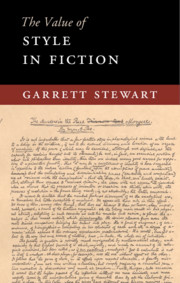Book contents
5 - Inventory: Some Terms of Engagement – A to Z
Published online by Cambridge University Press: 01 June 2018
Summary
The fact that the following limited list, in reviewing only vocabulary risen to the occasion of given illustrations in the preceding chapters, offers a mix of categories – variously drawn from linguistics, phonetics, etymology, grammar, rhetoric, poetics, and narrative theory – is exactly the point about the amalgamating work of style.
Absolute Construction: a grammatical halfway house (derived from the Latin “ablative absolute”) that is not quite freestanding as syntax, but is instead balanced independently between clause (full predication) and participial phrase (latched to a main sentence form or grammatical “kernel”), as in “pumps going in leaky ships” (Dickens); often part of the syntactical annex that builds a cumulative sentence
Adjective Chain: epithets piled up before (sometimes after) a noun without separate punctuation, a device frequent in Dickens (“a poor little reedy piping old gentleman”) and turned melodramatic in James with “the wide overwhelming presence” and all but mannerist in Faulkner (“the long still hot weary dead September afternoon”); often involving a sequence of “restrictive” adjectives applying separately, one after the other, to the noun – rather than to another of its modifiers – and thus normally requiring the comma separation that is overridden by such a jammed or enchained effect
Alliteration: the opening of separate words with the same consonant or vowel sound, as in the satire of “crumbling country seats” (Waugh) – as immediately expanded into the comparable cross-stitched silliness of soundplay in “illiterate lairds from wet granite hovels in the Highlands”
Anagram: the shuffling of the same letters for another separate lexical unit, usually a whole word, either in graphic form (like silent/listen) or (less discussed) in phonetic form – and sometimes only as involved, in quasi-anagrammatic fashion, with internal syllabic matter rather than whole word units, as in “bird-girl girdled” (Ellison), or shunted into the eye-only effect of short- against long-u sounds in “pumice”/“spume” (McCarthy)
Anaphora: metaphoric function (“likeness”) in a strictly linguistic rather than figurative sense, forged by repetition at the beginning of sequential phrases or clauses, as in the fourfold case of “in and out” repeated as adverbial header in the nautical density of Thames traffic (Dickens) or the antiquing of prose in “no Wall thick, nor Mind compos'd, nor valley remote enough” (Pynchon)
- Type
- Chapter
- Information
- The Value of Style in Fiction , pp. 127 - 136Publisher: Cambridge University PressPrint publication year: 2018

